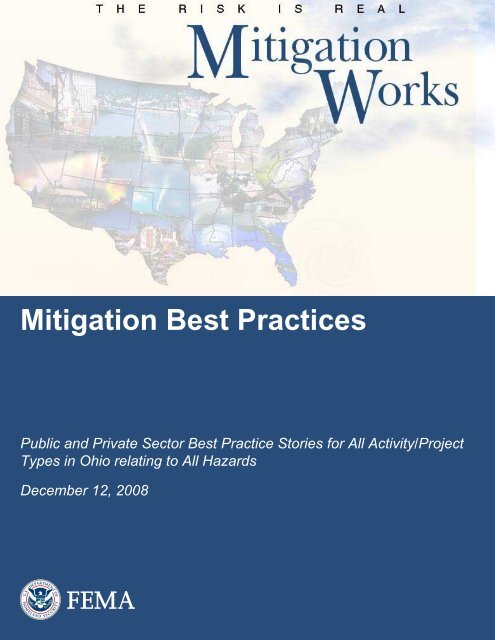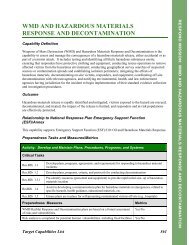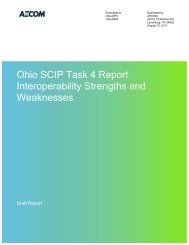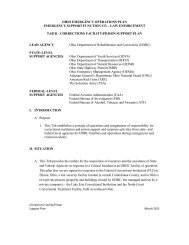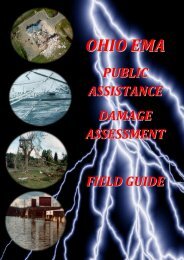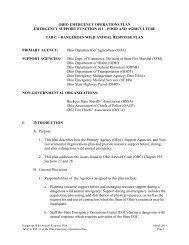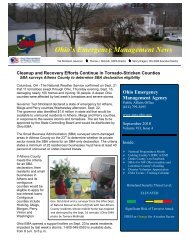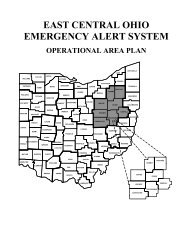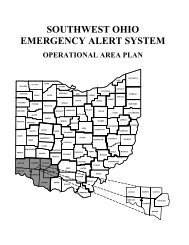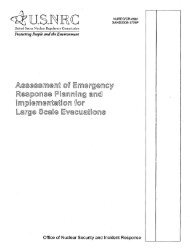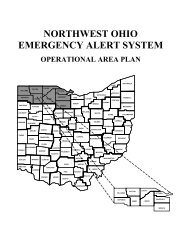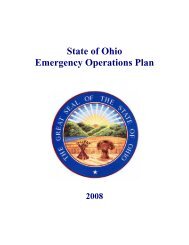Mitigation Best Practices - Ohio Emergency Management Agency ...
Mitigation Best Practices - Ohio Emergency Management Agency ...
Mitigation Best Practices - Ohio Emergency Management Agency ...
Create successful ePaper yourself
Turn your PDF publications into a flip-book with our unique Google optimized e-Paper software.
<strong>Mitigation</strong> <strong>Best</strong> <strong>Practices</strong><br />
Public and Private Sector <strong>Best</strong> Practice Stories for All Activity/Project<br />
Types in <strong>Ohio</strong> relating to All Hazards<br />
December 12, 2008
Table of Contents<br />
Rossilli's Restaurant Saved by an Inch of Prevention 1<br />
Silver Jackets: Bringing Agencies Together for the Benefit of Communities 2<br />
Acquisition in Cambridge Residents Like "View From the Top" 3<br />
Athens County Retrofit Homeowner Pleased With Result 4<br />
Community Buy-In Helps City of Jackson Benefits 5<br />
Miller South Chose Elevation Lawrence County 6<br />
Elevate Above Flooding Disaster Pomeroy and Rutland Benefit 7<br />
Small But Determined Village of Rarden, <strong>Ohio</strong> 8<br />
Two Birds, One Stone Village of Aberdeen, <strong>Ohio</strong> 9<br />
Future Disaster Damage Abated Morgan County 10<br />
Home Elevation in <strong>Ohio</strong> Once is More Than Enough 11<br />
New Richmond, <strong>Ohio</strong>, Acquisitions HMGP Acquisitions 12<br />
Breaking the Cycle of Devastation Reducing Damages in Southern <strong>Ohio</strong> 13<br />
Smart Recovery <strong>Mitigation</strong> Campaign <strong>Ohio</strong>'s <strong>Mitigation</strong> Awareness Program 14<br />
Village of Fort Recovery Acquisition and Relocation 15
Rossilli's Restaurant<br />
Saved by an Inch of Prevention<br />
Findlay, OH - Two days after the rampaging Blanchard River overflowed its banks last<br />
August and submerged downtown Findlay under more than a foot of water, Meg<br />
Rossilli stood in front of the restaurant she owns with her brother and her husband.<br />
Hancock County,<br />
<strong>Ohio</strong><br />
Located less than two blocks away from the bridge on Main Street that crosses over the<br />
river, Rossilli’s Restaurant, like many of the stores and offices in the neighborhood,<br />
could have sustained major, even bankrupting, damages from the 100-year flood.<br />
In this case, the difference between disaster and setback was a matter of a single inch.<br />
“When we moved to our new location (in 2003), we wanted to raise up the dining room<br />
floor by a foot,” says Meg’s brother and co-owner, Gary. The contractor and the city<br />
suggested raising the floor 13 inches instead of 12, in addition to using a more<br />
expensive, pressurized water-resistant wood. Being concerned with the additional cost<br />
for both modifications, they hesitated.<br />
But ultimately they decided to play it safe and spend the money not only on the extra<br />
height, but also on the pressurized water-resistant wood, in both the dining room and<br />
the kitchen in the back.<br />
Four years later, a summer storm settled over northwest <strong>Ohio</strong>, dumping up to 9 inches<br />
of rain in a single day on the farms and small towns. Creeks, streams, drainage<br />
systems, rivers – they all overflowed in the predominantly flat region.<br />
Down Main Street from the river, the Rossillis and Mike Eynon, Meg’s husband and<br />
business partner, piled sandbags three feet high in the narrow alcove of their entrance.<br />
Flood waters came in anyway, and the bar area in the front got flooded.<br />
Flood water crept up the ramp to the dining room, but stopped less than an inch from<br />
the raised floor.<br />
Quick Facts<br />
Sector:<br />
Private<br />
Cost:<br />
Amount Not Available<br />
Primary Activity/Project:<br />
Retrofitting, Non-structural<br />
Primary Funding:<br />
Property Owner, Commercial<br />
Page 1 of 15
Silver Jackets: Bringing Agencies<br />
Together for the Benefit of Communities<br />
The State of <strong>Ohio</strong> - Many natural disasters of recent times have highlighted the need<br />
for government agencies to work together not only in the response and recovery phase<br />
of the disaster cycle, but also in the pre-disaster mitigation phase. The Silver Jackets<br />
Program aims to accomplish that through providing a more formal and consistent<br />
strategy for implementing an interagency approach to planning and applying measures<br />
to reduce the risks associated with natural hazards.<br />
Essentially, this program proposes establishing an interagency team for each state,<br />
comprised of the Federal <strong>Emergency</strong> <strong>Management</strong> <strong>Agency</strong> (FEMA), the US Army<br />
Corps of Engineers (USACE), the State National Flood Insurance Program (NFIP)<br />
coordinator, and the State Hazard <strong>Mitigation</strong> Officer (SHMO) as standing members and<br />
lead facilitators. This increased collaboration between federal and state level agencies<br />
intends to find more ways to leverage resources between agencies, improve public<br />
outreach in risk management, and create a mechanism to collectively solve issues<br />
through familiarity with other agencies’ procedures and better interagency<br />
communication.<br />
Now that it has been active for over a year in the State of <strong>Ohio</strong>, the Silver Jackets<br />
Team has enjoyed some positive results. Though initially hesitant, the State of <strong>Ohio</strong><br />
now fully endorses the team which has received praise from elected officials. Another<br />
important outcome of the project was the discovery of the amount of data available.<br />
Several agencies contributed mapping and GIS information, resulting in new sources of<br />
information and opportunities becoming available. Finally, the improved communication<br />
between agencies has resulted in a better understanding of each agency’s programs<br />
and resource constraints.<br />
State-wide,<br />
<strong>Ohio</strong><br />
Quick Facts<br />
Sector:<br />
Public<br />
Cost:<br />
Amount Not Available<br />
Primary Activity/Project:<br />
Training<br />
Primary Funding:<br />
Other FEMA funds/ US Department of<br />
Homeland Security<br />
While the Silver Jackets Program will evolve over time, its initial test run in Marietta has<br />
proven successful in achieving the goals it set forth of increasing communication<br />
between government agencies for the benefit of states and communities.<br />
Page 2 of 15
Acquisition in Cambridge<br />
Residents Like "View From the Top"<br />
Cambridge, OH - "It was a bad situation turned good," said Ron LePage, a buyout<br />
participant, in Cambridge, OH. Cambridge, with a population of 13,000, sits at the<br />
foothills of the Appalachian Mountains in Guernsey County. Homes are nestled in the<br />
rolling terrain, a dream for those at the peak, but the runoff from heavy rainfall plagues<br />
homes at the lower elevations. The acquisition project primarily focused on 60-65<br />
homes suffering from decades of loss due to repetitive flooding. In the past decade<br />
Guernsey County has endured three Presidential Declared Disasters. The most severe<br />
flooding in recorded history occurred five years ago. Relentless storms pounded the<br />
area on June 27, 1998 with the floodwaters cresting on June 30th. The waters didn't<br />
recede to below flood stage until July 4th.<br />
Guernsey County,<br />
<strong>Ohio</strong><br />
In its wake, the flood left more than 100 residents with extensive damage to their<br />
homes. "It was devastating," said Michael Coulter, who had two inches of water in the<br />
top level of his tri-level home. The lower levels were completely immersed. "I don't<br />
know what we would have done without FEMA."<br />
The stress associated with the flood recovery and the fear of impending storms were<br />
the deciding factors for many homeowners who elected to participate in the buyout.<br />
Ron LePage and Peter Blazvick lived in the low-lying neighborhood, which had the<br />
largest number (26) of acquired and (4) retrofitted properties. The source of the flooding<br />
was Gordon's Run, a creek near their homes.<br />
The Hazard <strong>Mitigation</strong> Grant Program (HMGP), activated in a Presidential Disaster<br />
Declaration, is designed to relieve communities of future flood losses and give<br />
homeowners of flooded properties options. The community of Cambridge chose to<br />
apply for these funds and use them for an acquisition/retrofitting project. Participation in<br />
the buyout process is voluntary, but homeowners are required to go through a cost<br />
benefit analysis to justify their involvement in the project. These funds would be used to<br />
purchase the properties and demolish the structures. Then, the property would be left<br />
in perpetuity to the community as open space, never to be built upon again. Other<br />
homeowners took the option of retrofitting the flooded portions of their home to<br />
minimize future damage.<br />
In 1998, City Engineer Jeanette Wierzbicki received notice from the State that<br />
mitigation funding was available through the HMGP to purchase homes that sustained<br />
repetitive flood damage. She was the initial driving force behind the effort.<br />
On January 3, 2004, severe storms poured five inches of water in 72 hours over large<br />
portions of the State. Temperatures plummeted to below zero, warmed and again<br />
returned to dangerously cold. Guernsey County was one of the 14 designated counties<br />
included in the Presidential Declaration resulting from this severe storm and rain event.<br />
The mitigation efforts begun in 1998 proved successful. Several of the acquired<br />
properties (now empty lots) had standing water from the rain.<br />
Coulter, Blazvick and LePage expressed concern for those who remain in their former<br />
neighborhoods. These three homeowners, pleased with their participation in the<br />
project, have relocated in Cambridge to homes on higher ground.<br />
Quick Facts<br />
Sector:<br />
Private<br />
Cost:<br />
Amount Not Available<br />
Primary Activity/Project:<br />
Acquisition/Buyouts<br />
Primary Funding:<br />
Hazard <strong>Mitigation</strong> Grant Program (HMGP)<br />
Page 3 of 15
Athens County Retrofit<br />
Homeowner Pleased With Result<br />
Athens County, OH - Kara Edmonds is Community Development Coordinator for the<br />
Tri-County Community Action <strong>Agency</strong> serving Athens, Hocking and Perry counties in<br />
southeastern <strong>Ohio</strong>. Athens County suffered isolated flooding along several streams<br />
during the March 1997 disaster, in areas that had been damaged in two previous<br />
declared floods since 1990.<br />
Athens County,<br />
<strong>Ohio</strong><br />
Edmonds was designated by county commissioners to work with FEMA and OEMA in<br />
pursuing mitigation assistance for repetitively damaged properties, including two homes<br />
bordering Sugar Creek within two miles of the Community Action offices on State Route<br />
550. The owner of one of those residences is <strong>Ohio</strong> University journalism professor<br />
Cassandra Reese.<br />
In the aftermath of previous flooding into the "walk-out" lower level of Reese's hillside<br />
home, she had invested more than $22,000 to erect a three-foot-high floodwall around<br />
the rear and side of the house, replace damaged lower-level drywall, jack up the slab<br />
floor, elevate her water heater and washer/dryer and add a brick channel to carry runoff<br />
away from the house and down her driveway.<br />
But when the March 1997 downpour created unprecedented runoff, Reese found that<br />
three feet of water had found its way around and under her precautions into her lower<br />
level, ruining a heat pump and electrical breaker box and causing structural damage to<br />
deck supports. Her next step was to seek help through Kara Edmonds and the Hazard<br />
<strong>Mitigation</strong> Grant program. Edmonds prepared and submitted a successful grant<br />
application and helped Reese get architectural advice through the <strong>Ohio</strong> <strong>Emergency</strong><br />
<strong>Management</strong> <strong>Agency</strong> <strong>Mitigation</strong> Branch.<br />
They determined that during extremely heavy rains, water near the floodwall<br />
accumulated so rapidly that it backed up, creating a pond under Reese's deck from<br />
which it seeped under a rear doorway and into the lower level.<br />
In 1998, with the help of a $16,000 mitigation grant, Reese was able to retrofit her<br />
home by having her deck partially rebuilt, a waterproof rear door installed that would<br />
not allow high water to enter the house; a one-way check valve installed in her flood<br />
wall that that would allow water to flow only away from the house; her heat pump<br />
condenser elevated on a masonry platform to above the peak flood level; and the<br />
electrical circuit box and meter moved from the rear to the front wall of her lower level<br />
and elevated to six feet above the floor.<br />
While flood waters haven't reached or exceeded the 1997 levels since then, Reese said<br />
she is confident her flooding problems are solved and was very pleased with the<br />
attitude and performance of Edmonds and the OEMA team. "After everything I had<br />
tried, they gave me good advice, and the additional work they paid for was done well.<br />
I'm in no hurry to have the water come up high enough to test it all again, but I'm<br />
comfortable that I won't be looking at major repair bills if we do have another flood."<br />
Edmonds reports that, while neighbors were out sweeping standing water from their<br />
driveways and patios after recent heavy rains, she has seen Reese standing on her<br />
deck smiling while the new check valve keeps her high and dry.<br />
Quick Facts<br />
Sector:<br />
Private<br />
Cost:<br />
$16,000.00 (Estimated)<br />
Primary Activity/Project:<br />
Retrofitting, Structural<br />
Primary Funding:<br />
Hazard <strong>Mitigation</strong> Grant Program (HMGP)<br />
Page 4 of 15
Community Buy-In Helps<br />
City of Jackson Benefits<br />
Jackson, OH - Unlike many of the communities which suffered major damage in the<br />
March 1997 flood, Jackson, <strong>Ohio</strong>, (population 6,700) is located more than 30 miles<br />
from the <strong>Ohio</strong> River in the state's hilly and scenic southeastern corner. The sources of<br />
its recurring flood problems are Horse Creek and Salt Lick Creek, two usually<br />
unthreatening streams that carry runoff from nearby high ground through the town on<br />
their way to the <strong>Ohio</strong>.<br />
Jackson County,<br />
<strong>Ohio</strong><br />
When the area around Jackson receives unusually heavy rains, as it did on March 1-2,<br />
1997, both narrow, winding creeks often receive more rapid runoff from miles of<br />
surrounding hillsides than their banks can contain. Drainage and stream flows are<br />
impacted to some degree by upstream stretches of land formerly used for logging and<br />
strip mining, and the creeks also receive heavy runoff from recently widened stretches<br />
of U.S. Route 35--now a major four-lane highway.<br />
Homes in several low-lying and poorly drained areas of the town suffered considerable<br />
damage in 1963, 1968 and again in 1975 when sustained spring rains took the creeks<br />
out of their banks. But according to Jackson city building projects coordinator Story<br />
Cool and Mayor Tom Evans, the March 1997 downpour and its aftermath caused "the<br />
worst flooding anyone around here can remember." One often-damaged area, roughly<br />
a half-mile square along Central Avenue and Freeman Street that suffered street<br />
flooding and standing water after even normal rains, was under so much moving water<br />
for so long during the '97 event that dozens of homes were destroyed or damaged<br />
beyond repair.<br />
"FEMA and OEMA recovery teams arrived while the water was still receding, and set<br />
up a Disaster Recovery Center at the local Odd Lots store," said Evans. Once streets<br />
were re-opened, utilities were back in operation and debris removal underway, Evans<br />
said he and his service director met with OEMA <strong>Mitigation</strong> Branch staff in Columbus to<br />
learn about the HMGP program.<br />
Evans noted that, at an early point in the planning process, several members of the<br />
committee strongly advocated that the best mitigation strategy would be to dredge the<br />
creek beds at several choke points. "We had experts from the Department of Natural<br />
Resources and Army Corps of Engineers come to the next meeting and listen to their<br />
suggestions. They explained that dredging wouldn't prevent flooding after heavy<br />
rains…just move it downstream another few hundred yards," said Evans. "They told us<br />
the real problem was that these creeks are going to overflow periodically no matter<br />
what you do, and that our most damaged neighborhood was going to keep on getting<br />
flooded because it sits smack in the middle of the natural floodplain."<br />
Quick Facts<br />
Sector:<br />
Private<br />
Cost:<br />
Amount Not Available<br />
Primary Activity/Project:<br />
Acquisition/Buyouts<br />
Primary Funding:<br />
Hazard <strong>Mitigation</strong> Grant Program (HMGP)<br />
After they got that information and were able to ask a few questions, Evans said even<br />
the strongest advocates of dredging backed away from that alternative and ultimately<br />
supported property acquisition as the best course of action.<br />
The City of Jackson received a $288,000 HMGP grant and state and local matching<br />
funds that allowed it to acquire 4 vacant lots and permanently remove 31 repetitively<br />
damaged structures from the flood-prone area along Central Avenue and Freeman<br />
Street.<br />
Page 5 of 15
Miller South Chose Elevation<br />
Lawrence County<br />
Lawrence County, OH - As coordinator of seven different mitigation projects after<br />
extensive flooding along the <strong>Ohio</strong> River in 1997, Doug Cade of Lawrence County<br />
Community Action, was primarily involved in acquiring and demolishing severely<br />
damaged properties. But in his meetings with residents and review of data from the<br />
Miller South flood area, Cade found that elevation of some flood-damaged properties<br />
was not only a viable alternative, but also the best one.<br />
Lawrence County,<br />
<strong>Ohio</strong><br />
The unincorporated area of southeastern Lawrence County designated as Miller South<br />
in Cade's grant application is one of the most-often flooded areas in the entire state--<br />
with a total of 27 documented flood events since local record-keeping started in 1832.<br />
Eight of those floods have occurred since 1950. The small residential area seeking<br />
mitigation assistance there consisted of six large, upscale homes that had suffered<br />
repeated but not catastrophic damage in several recent high-water events.<br />
"When I talked with the property owners and we looked at the data, there were a couple<br />
of good reasons to look at alternatives to acquisition," said Cade. "First, these were<br />
large, fairly new homes on big lots that had a high pre-disaster market value--which<br />
meant buyouts would be prohibitively expensive. Second, the first floors of most of the<br />
properties were only a couple of feet below the Base Flood Elevation; and third, the<br />
families really wanted to stay in the area and were committed to following through with<br />
the structural work if we would help get government funding."<br />
Cade said the relatively straightforward structural changes that were needed to raise<br />
the Miller South homes to a disaster-resistant elevation were a major supporting factor.<br />
"After we talked with engineers and got estimates, it seemed pretty clear that--for these<br />
types of houses-- adding three feet of elevation was kind of a magic number," he said.<br />
"At three feet the expense and complexity of the work were clearly cost-effective. Once<br />
you got much over three feet of elevation, the jobs got more complicated and the costs<br />
went up fast."<br />
Quick Facts<br />
Sector:<br />
Private<br />
Cost:<br />
Amount Not Available<br />
Primary Activity/Project:<br />
Elevation, Structural<br />
Primary Funding:<br />
Local Sources<br />
The Miller South proposal submitted and ultimately approved by OEMA and FEMA<br />
included funding for six property elevations. By the time applications were reviewed and<br />
approved and funds became available, two property owners changed their minds but<br />
four stayed and went through with the elevation process.<br />
As of early 2002, all four families were still living in their newly elevated homes, with<br />
significantly reduced danger of injury or property damage in extreme weather --and<br />
enhanced property values based on the improved disaster resistance of their houses.<br />
Lawrence County kept four upscale properties on the active tax rolls, and greatly<br />
reduced the prospect of future public costs for emergency services, temporary housing,<br />
debris removal, etc. in one of its most-often flooded areas.<br />
Page 6 of 15
Elevate Above Flooding Disaster<br />
Pomeroy and Rutland Benefit<br />
Salisbury, MD - Salisbury Township is home to the river-crossing town of Pomeroy,<br />
population 2,200, near the southeastern corner of the state where U.S. Route 33<br />
crosses the <strong>Ohio</strong> River into West Virginia.<br />
Meigs County,<br />
<strong>Ohio</strong><br />
Similar to most river towns, Pomeroy and the surrounding township have dealt with<br />
high water many times in their nearly 20-year history. Unfortunately, cycles of drought<br />
followed by heavy rain, deforestation of some area hillsides and increased runoff from<br />
recently widened state and federal highways contributed to even more frequent local<br />
flood damage during the late 1990's.<br />
The village of Rutland is about five miles west of Pomeroy. It also has a history of flood<br />
damage, but the culprits there are Little Leading and Beech Grove Creeks, which carry<br />
runoff from the steep bluffs above the <strong>Ohio</strong> Valley through the village of about 500<br />
residents.<br />
When flash flooding occurs along the creeks, it often blocks State Route 124, the main<br />
east/west highway, and other emergency routes; and poses a serious safety threat to<br />
local residents, nearby property and public infrastructure.<br />
The drenching rains and excessive runoff of March 1-2, 1997, hit Pomeroy and Rutland<br />
residents hard…but that disaster also provided an opportunity for some local families to<br />
escape the repeating cycle of damage, repair and more damage through funding for<br />
post-recovery mitigation projects. Those projects included elevation of 18 homes that<br />
had suffered significant damage in several previous floods.<br />
Quick Facts<br />
Sector:<br />
Private<br />
Cost:<br />
Amount Not Available<br />
Primary Activity/Project:<br />
Elevation, Structural<br />
Primary Funding:<br />
Hazard <strong>Mitigation</strong> Grant Program (HMGP)<br />
Page 7 of 15
Small But Determined<br />
Village of Rarden, <strong>Ohio</strong><br />
Rarden, OH - Rarden, population 176, is a classic "wide spot in the road" rural village<br />
that straddles an eight-block stretch of State Route 73 in western Scioto County, about<br />
25 miles north of the <strong>Ohio</strong> River. Other than its proudly up-to-date volunteer fire station,<br />
the village's only distinguishing feature used to be its picturesque location in a natural<br />
hollow at the convergence of Rarden Creek and Jessie's Run. Now there's also a creek<br />
-front village park.<br />
In March 1997, when two days of non-stop downpours and runoff from surrounding hills<br />
turned both local streams into raging rivers, many of Rarden' s 60-some households<br />
suffered basement flooding or worse. Road closures shut off the village from outside<br />
help for two days and loss of water and electric service made life miserable for most<br />
residents. But the danger and loss to Copas and her neighbors in a low-lying residential<br />
area near the creeks was infinitely worse. They awoke early on the second morning of<br />
storms barely in time to escape from a rapidly expanding "lake" of floodwater erupting<br />
from the creek bed. By the afternoon of March 2, the water had reached a depth of 10<br />
feet - submerging every structure within 200 yards of the creek beds nearly to the level<br />
of first floor ceilings.<br />
Village Mayor Anna Gardner, who was flooded out of her own home and lived for<br />
weeks in a second-story room above a garage, worked closely with county and local<br />
safety officials over the next several days to help re-open roads, get rescue and<br />
recovery aid to those who needed it and provide daily meals for the whole community<br />
at the fire house until utility service was restored.<br />
Volunteers, including the Red Cross and a Boy Scout troop from Granville, <strong>Ohio</strong>,<br />
arrived within days of the flood to bring food and drinking water and help with clean up<br />
and debris removal. Most village residents who suffered damage, including Gardner,<br />
eventually were able to repair and restore their homes to livability with help from FEMA<br />
emergency grants and/or loans from the U.S. Small Business Administration. But postdisaster<br />
assessments found that certain homes in the creek-front neighborhood were<br />
beyond repair.<br />
Scioto County,<br />
<strong>Ohio</strong><br />
Quick Facts<br />
Sector:<br />
Private<br />
Cost:<br />
$229,000.00 (Estimated)<br />
Primary Activity/Project:<br />
Acquisition/Buyouts<br />
Primary Funding:<br />
Hazard <strong>Mitigation</strong> Grant Program (HMGP)<br />
In late March Gardner received a phone call from the Scioto County <strong>Emergency</strong><br />
<strong>Management</strong> <strong>Agency</strong>, inviting representatives from Rarden to attend a county-wide<br />
meeting with FEMA and OEMA staff to help local officials learn about mitigation and the<br />
HMGP grant process.<br />
"We knew what a desperate situation the flooded-out families were in, and we also<br />
knew we had a chance for the village to avoid future rescue and recovery operations<br />
and save thousands of tax dollars that would be wasted to repair or rebuild houses on<br />
that land," Gardner said. "We decided on the spot that we'd do everything possible to<br />
get a grant. In fact, we sat down and completed a pre-application form right there<br />
before we left the meeting."<br />
An HMGP grant of $158,000 and state/local funding totaling $71,000 were approved for<br />
the acquisition of four homes, one mobile home and one vacant lot in the flood-prone<br />
creek front area.<br />
Page 8 of 15
Two Birds, One Stone<br />
Village of Aberdeen, <strong>Ohio</strong><br />
Aberdeen, OH - <strong>Ohio</strong> River flooding is nothing new to the village of Aberdeen and its<br />
population of 545. Before March 1997, the historic riverfront community about 50 miles<br />
east of Cincinnati had lived through five major 20th century flood events (1913, '36, '37,<br />
'59 and '96).<br />
Brown County,<br />
<strong>Ohio</strong><br />
While past efforts had been made to reduce the community's exposure to repetitive<br />
damage, including adoption of a local floodplain ordinance in 1983, Aberdeen had an<br />
obvious "Achilles heel" in terms of repeated property damage, danger to residents and<br />
public safety forces and negative impact on the community's appearance and quality of<br />
life.<br />
That vulnerable spot was a stretch of downtown river frontage roughly 10 blocks long<br />
by three blocks deep which slopes dramatically down from the village's main street<br />
(U.S. Route 52) toward the <strong>Ohio</strong> River. For the last 100-150 yards before the river<br />
bank, the hillside flattens into a level plain 8-10 feet below the Base Flood Elevation<br />
(100-year flood level). As a practical matter, during periods of heavy rain or when the<br />
river begins to escape its banks, this low-lying area functions as a natural drainage<br />
basin which can fill very rapidly with several feet of water.<br />
According to current Aberdeen Mayor Billie Eitel, who took office in 2000, local safety<br />
forces and volunteers had been called out on numerous occasions prior to 1997 to<br />
rescue residents of this area from rising water and tow mobile homes to safer ground.<br />
Because of the unprecedented speed with which runoff accumulated in March 1997,<br />
only a handful of mobile homes could be removed from the riverfront area before it<br />
became impassable. Virtually all of the three dozen housing units in the low-lying area<br />
were destroyed or significantly damaged by rampaging floodwaters as the <strong>Ohio</strong> surged<br />
out of its banks during the next several days.<br />
Quick Facts<br />
Sector:<br />
Public/Private Partnership<br />
Cost:<br />
Amount Not Available<br />
Primary Activity/Project:<br />
Acquisition/Buyouts<br />
Primary Funding:<br />
Hazard <strong>Mitigation</strong> Grant Program (HMGP)<br />
During FEMA-assisted local recovery efforts, village officials were put in contact with<br />
the OEMA <strong>Mitigation</strong> Branch and briefed on the availability of federal hazard mitigation<br />
grants. In discussing the possibilities with area residents and developing a local HMGP<br />
proposal, it became clear to community leaders that they had a unique opportunity to<br />
"kill two birds with one stone" through a property acquisition project that would: a)<br />
eliminate most structures from the riverfront area and b) convert the village's "front<br />
yard" along a scenic stretch of the <strong>Ohio</strong> from an unsightly jumble of substandard<br />
housing into a ¾ mile long riverfront park.<br />
While state and federal officials approved Aberdeen's grant proposal in early 1998, the<br />
village and its leaders encountered delays and difficulties in implementing the buyout<br />
project.<br />
While a few isolated homes still remain in the mitigated area, by early 2002 Mayor Eitel<br />
proudly pointed out a new volunteer-constructed (and flood resistant) gazebo that<br />
serves as a bandstand for free summer concerts; a string of new merchant-donated<br />
riverbank park benches and a grassy expanse of new public parkland that stretches<br />
from the eastern edge of the business district to a pre-existing municipal boat dock and<br />
children's playground several blocks away.<br />
Page 9 of 15
Future Disaster Damage Abated<br />
Morgan County<br />
Morgan County, OH - When it comes to repairing or replacing disaster-damaged<br />
infrastructure, federal and state recovery officials look for cost effective opportunities to<br />
reduce damages during future events. Such was the case when the Morgan County<br />
Highway Department applied for funding to replace a twin culvert system. The culvert<br />
system became overwhelmed by Hurricane Ivan floodwaters in September 2004, which<br />
washed out the roadbed of Compressor Road north of Marion Township, Morgan<br />
County.<br />
Morgan County,<br />
<strong>Ohio</strong><br />
Extra funds were dedicated to build one large, arched culvert and repair the roadbed to<br />
prevent flooding in the future. The work was done just in time. When floods hit in<br />
January 2005, many roads in the area were heavily damaged but the new culvert<br />
performed up to expectations and Compressor Road at this site came away unscathed.<br />
This was all made possible by Morgan County becoming eligible for the FEMA and<br />
<strong>Ohio</strong> <strong>Emergency</strong> <strong>Management</strong> <strong>Agency</strong> (<strong>Ohio</strong> EMA) Public Assistance (PA) program<br />
under a Presidential declaration of a major disaster for that flood. The PA program,<br />
administered by the state, provides reimbursements to state agencies, local<br />
jurisdictions and certain non-profit organizations that provide a government-like service<br />
for eligible disaster-related costs and damages. Services include debris removal,<br />
emergency protective measures, and repair and restoration of disaster-damaged public<br />
infrastructures. FEMA provides 75 percent reimbursement of the eligible costs.<br />
Under one section of the PA program, administrators are empowered to make<br />
additional obligations of funding for a project that meets the program mitigation funding<br />
criteria if those mitigation measures are cost effective. The Marion Township<br />
Compressor Road culvert replacement met these criteria. In most cases, PA repair and<br />
restoration funding brings damaged infrastructure back to pre-disaster conditions.<br />
Quick Facts<br />
Sector:<br />
Public<br />
Cost:<br />
$6,000.00 (Estimated)<br />
Primary Activity/Project:<br />
Flood Control<br />
Primary Funding:<br />
Other FEMA funds/ US Department of<br />
Homeland Security<br />
One major FEMA and <strong>Ohio</strong> EMA Public Assistance program goal is to mitigate,<br />
wherever it is cost effective, when restoring damaged infrastructure so the repaired<br />
facility is better able to withstand future disaster damages. A little extra money spent<br />
now may save untold funds later. Such was the case with the Compressor Road<br />
repairs.<br />
Altogether, it would cost about $3,200 to replace the culverts and roadbed to predisaster<br />
conditions. For a little more than $6,000, an arched 85-inch by 54-inch culvert<br />
replaced the twin culverts.<br />
"By adding extra funds to provide a larger culvert, we believe that the culvert and<br />
roadway will have a much better chance of not being damaged in a similar flooding<br />
event," said FEMA's Region V Acting Regional Director Janet Odeshoo.<br />
Page 10 of 15
Home Elevation in <strong>Ohio</strong><br />
Once is More Than Enough<br />
Muskingum County, OH - Once was more than enough for the McDonoughs. Jim and<br />
Carol McDonough bought a summer/weekend, getaway modular home about 100 feet<br />
from the Muskingum River in Blue Rock, <strong>Ohio</strong> because of its sweeping river view and it<br />
seemed to sit above most of the river flooding that occurs in this area, Ms. McDonough<br />
said. "The structure is a 26 by 50 foot, wood frame house", James McDonough said.<br />
It's about 10 years old.<br />
Muskingum County,<br />
<strong>Ohio</strong><br />
"Then came the January 2005 flooding, the highest in 50 years according to the locals"<br />
said Ms. McDonough. The McDonoughs ended up with four inches of water on their<br />
first floor. "We had to tear out our carpet and insulation. It was a mess", said Jim<br />
McDonough. " I estimate we had about $5,000 in damage. In addition to the monetary<br />
cost, there also was the loss of use and time spent cleaning up." They decided they did<br />
not want to go through that again. "We chose to elevate", Ms. McDonough said. "Since<br />
this was the highest water in 50 years, and we had four inches on our first floor, we<br />
decided to go up 28 inches higher than the four courses of concrete blocks."<br />
James McDonough also went on to the Internet and visited the <strong>Ohio</strong> Department of<br />
Natural Resources. "I found they had the base flood elevation for this area on their site.<br />
It is 25 feet. I elevated so I would be a couple of feet above that" McDonough said. The<br />
base flood elevation determines the extent a 100-year flood (a flood that has a one<br />
percent chance of occurring in a given year) will rise to in a given area. Contractors<br />
were hired to lift the home by installing piers four concrete courses high under the<br />
home and then set the home back on the piers.<br />
"I was fortunate with my contractor" McDonough said. "He had done other work for me.<br />
When I broached the elevation project to him, he said he could do it." The McDonoughs<br />
are well satisfied with the finished project.<br />
The McDonoughs think the elevation will prove a good investment. "It cost us $8,000<br />
for the elevation work" McDonough said. But when the Muskingham River rises again,<br />
as it does every year says Carol McDonough, "those 32 added inches should keep us<br />
high and dry." Based on their costs and losses from this event, they believe the work<br />
will pay for itself if water from the next two floods like the January 2005 flood does not<br />
reach the structure's first floor. This is what is known as mitigation; taking steps now to<br />
reduce the chances of sustaining future disaster damages.<br />
"We commend the McDonoughs for elevating their structure. They took responsibility<br />
for themselves and used their own resources to protect themselves from future<br />
flooding" said Acting Regional Director Janet M. Odeshoo for FEMA Region V.<br />
The State of <strong>Ohio</strong> <strong>Emergency</strong> <strong>Management</strong> <strong>Agency</strong> (<strong>Ohio</strong> EMA) administers the<br />
hazard mitigation program. <strong>Ohio</strong> EMA Executive Director Nancy Dragani said all too<br />
often folks in harm's way wait for the government to solve their problems, but many<br />
times the solution is in their own hands. "The McDonoughs are a tremendous role<br />
model for what can be done with a little money and lots of gumption and will."<br />
Quick Facts<br />
Sector:<br />
Private<br />
Cost:<br />
$8,000.00 (Actual)<br />
Primary Activity/Project:<br />
Elevation, Structural<br />
Primary Funding:<br />
Homeowner<br />
Page 11 of 15
New Richmond, <strong>Ohio</strong>, Acquisitions<br />
HMGP Acquisitions<br />
New Richmond, OH - New Richmond, a small, historic <strong>Ohio</strong> village about 20 miles<br />
upriver from Cincinnati on the <strong>Ohio</strong> River, is no stranger to flooding. Its flooding history<br />
is most eloquently told in pictures.<br />
Clermont County,<br />
<strong>Ohio</strong><br />
New Richmond is also a town of resilient <strong>Ohio</strong>ans who want to keep their history alive<br />
and thriving. So they looked for ways to learn from the past and stop the cycle of<br />
destruction and reconstruction.<br />
During the 1996 and 1997 floods, a new way of dealing with the aftermath of flooding<br />
and other disasters had come into being – the Hazard <strong>Mitigation</strong> Grant Program<br />
(HMGP). Initiated by the Department of Homeland Security’s Federal <strong>Emergency</strong><br />
<strong>Management</strong> <strong>Agency</strong> (FEMA) and administered by state partners such as the <strong>Ohio</strong><br />
<strong>Emergency</strong> <strong>Management</strong> <strong>Agency</strong> (<strong>Ohio</strong> EMA), HMGP provides funding for projects that<br />
will reduce damages from future disasters.<br />
FEMA provides 75 percent of HMGP funding and provides technical assistance to the<br />
states in implementing an HMGP project. The states administer HMGP and determine<br />
what type of projects (i.e., acquisitions or elevations) will be funded. In acquisition and<br />
relocation projects, the properties acquired are turned into green space in perpetuity.<br />
New Richmond applied and became a participant in HMGP acquisitions projects based<br />
on January and June floods in 1996 and a March flood in 1997. Altogether, the projects<br />
acquired 43 structures, the lots they were located on and five bare lots for about $1.9<br />
million. These repetitively damaged structures permanently were removed from harm’s<br />
way and the village now has a green space along the river that has become a village<br />
gathering point.<br />
While the HMGP projects were a boon to New Richmond, it also came - as any new<br />
government program would - with its own issues to meet and overcome.<br />
The experiences of New Richmond Village Administrator David Kennedy, who was new<br />
to the village at the time of the1997 flood, is illustrative of the challenges an<br />
administrator would face with the HMGP program. These challenges also were met by<br />
constructive solutions that may help other HMGP project coordinators deal with issues<br />
that crop up.<br />
New Richmonders know the <strong>Ohio</strong> River will rise again and that parts of New Richmond<br />
will flood when it does. But because of HMGP and other local initiatives, New<br />
Richmond is much better prepared to deal with flooding than ever before. <strong>Mitigation</strong><br />
works.<br />
Quick Facts<br />
Sector:<br />
Private<br />
Cost:<br />
$2,300,000.00 (Estimated)<br />
Primary Activity/Project:<br />
Acquisition/Buyouts<br />
Primary Funding:<br />
Hazard <strong>Mitigation</strong> Grant Program (HMGP)<br />
Page 12 of 15
Breaking the Cycle of Devastation<br />
Reducing Damages in Southern <strong>Ohio</strong><br />
Meigs County, OH - Since 1964, <strong>Ohio</strong> has received 28 Presidential disaster<br />
declarations—22 of which were for flooding. To address the issue of flood risk, the<br />
State of <strong>Ohio</strong> has taken aggressive measures to assess areas of vulnerability and<br />
reduce the impact of flooding to those areas.<br />
Multiple Counties,<br />
<strong>Ohio</strong><br />
In 1990, <strong>Ohio</strong> implemented a state-wide hazard mitigation plan. The state has<br />
developed numerous mitigation programs and projects in conjunction with the federal<br />
government, under the supervision of the <strong>Ohio</strong> <strong>Emergency</strong> <strong>Management</strong> <strong>Agency</strong>. The<br />
acquisition project in Meigs County demonstrates that an investment in mitigation can<br />
be fully returned within only one or two subsequent floods.<br />
The Village of Rutland sits five miles from the <strong>Ohio</strong> River’s edge in south central Meigs<br />
County. Most of the village properties were over 50 years old, and most were<br />
susceptible to flash flooding from nearby creeks. The January floods of 1996 prompted<br />
the village to apply for FEMA’s Hazard <strong>Mitigation</strong> Grant Program (HMGP) to fund an<br />
acquisition project.<br />
The project involved the acquisition and demolition of 22 structures, elevating nine<br />
structures, relocating four structures, and retrofitting two structures. The estimated cost<br />
was just over $1 million. Although the project was approved in 1997, the area was<br />
subjected to heavy flooding prior to the start of the project, which was completed in<br />
1999.<br />
Thanks to the mitigation project, Lilly Kennedy’s home, flooded every year since 1995,<br />
was eight feet higher than in 1997, when first floor flooding reached a depth of four feet.<br />
When flooding occurred again in February of 2000, floodwater came up to nearly three<br />
feet around the foundation of Lilly’s house, but never threatened the interior of her<br />
home or her belongings. “This last time,” exclaims Lilly, “I just stood and watched as the<br />
water came up, knowing all the time that my son and I were safe.”<br />
Quick Facts<br />
Sector:<br />
Public<br />
Cost:<br />
$1,048,870.00 (Actual)<br />
Primary Activity/Project:<br />
Acquisition/Buyouts<br />
Primary Funding:<br />
Hazard <strong>Mitigation</strong> Grant Program (HMGP)<br />
Page 13 of 15
Smart Recovery <strong>Mitigation</strong> Campaign<br />
<strong>Ohio</strong>'s <strong>Mitigation</strong> Awareness Program<br />
The State of <strong>Ohio</strong> - The <strong>Ohio</strong> <strong>Emergency</strong> <strong>Management</strong> <strong>Agency</strong> and Department of<br />
Natural Resources spearheaded a "Smart Recovery" awareness campaign. The<br />
campaign aimed at educating the public about mitigation methods and strategies as<br />
well as persuading individuals as members of their communities to make smart<br />
recovery decisions.<br />
State-wide,<br />
<strong>Ohio</strong><br />
The campaign’s intent is for mitigation to become synonymous with "smart recovery."<br />
There are two main goals of the campaign. The first is to increase the general public's<br />
awareness of natural hazard risks and related costs versus the benefits of mitigation.<br />
The second is to enhance the realization that individual and community mitigation<br />
activities can reduce the injuries, loss of life, and loss of property resulting from a<br />
disaster.<br />
The campaign developed printed materials promoting smart recovery; aired radio,<br />
television and cable public service announcements; printed media advertisements;<br />
distributed caps, pins and stickers at public fairs and other public events; and<br />
developed a portable exhibit for use at State and local fairs, home shows and other<br />
public events.<br />
For the State, there are several benefits of the Smart Recovery <strong>Mitigation</strong> Campaign.<br />
The public will understand what mitigation means and how they can apply it to reduce<br />
future disaster damages. At-risk individuals will take more responsibility for reducing<br />
damages by pursuing mitigation projects and purchasing appropriate insurance. The<br />
<strong>Ohio</strong> community leaders will better understand how to utilize mitigation measures to<br />
build safer communities and foster strong economic development. The at-risk<br />
communities will be better prepared to develop plans that identify mitigation<br />
opportunities and implement mitigation projects that will result in safer communities.<br />
Quick Facts<br />
Sector:<br />
Public<br />
Cost:<br />
$250,000.00 (Estimated)<br />
Primary Activity/Project:<br />
Education/Outreach/Public Awareness<br />
Primary Funding:<br />
State sources<br />
Page 14 of 15
Village of Fort Recovery<br />
Acquisition and Relocation<br />
Fort Recovery, OH - The Village of Fort Recovery in west central <strong>Ohio</strong> is 20 miles<br />
southwest of the Wabash River. The Village experiences repetitive flooding from the<br />
Buck Ditch Basin, which flows through the center of the Village to reach the Wabash<br />
River. In 1996 the Village suffered from a damaging flood that prompted the<br />
implementation of an acquisition project.<br />
Mercer County,<br />
<strong>Ohio</strong><br />
The Village received funding to acquire six floodprone residential structures and<br />
physically relocate eight homes and the fire station to previously developed sites<br />
outside of the floodplain. In addition, four residences and six businesses utilized<br />
retrofitting techniques to floodproof the basements. The Village expects to have the<br />
entire project completed by the end of 1998.<br />
The key component to the success of the Village of Fort Recovery Hazard <strong>Mitigation</strong><br />
Project can be summed up in one word: cooperation. FEMA and <strong>Ohio</strong> <strong>Emergency</strong><br />
<strong>Management</strong> <strong>Agency</strong> introduced a project development process to assist communities<br />
in the development of solid projects that attack the problem by considering alternative<br />
solutions that meet the required criteria. Fort Recovery involved the public during<br />
meetings, and a core group composed of citizens and local officials was formed to<br />
evaluate options and develop the acquisition project application.<br />
Quick Facts<br />
Sector:<br />
Public<br />
Cost:<br />
$871,467.00 (Estimated)<br />
Primary Activity/Project:<br />
Acquisition/Buyouts<br />
Primary Funding:<br />
Hazard <strong>Mitigation</strong> Grant Program (HMGP)<br />
Page 15 of 15


